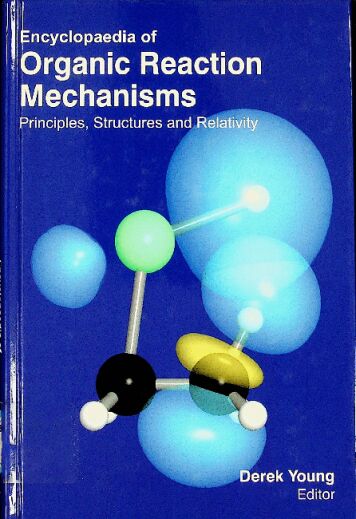书名:Encyclopaedia of organic reaction mechanisms
ISBN\ISSN:9781781540138,1781540136
出版时间:2012
出版社:Auris Reference,
前言
Organic chemistry has a strong tradition of naming a specific reaction to its inventor or inventors and a long list of so-called named reactions exists, conservatively estimated at 1000.A very old named reaction is the Claisen rearrangement (1912) and a recent named reaction is the Bingel reaction(1993). When the named reaction is difficult to pronounce or very long as in the Corey-House-Posner- Whitesides reaction it helps to use the abbreviation as in the CBS reduction. The number of reactions hinting at the actual process taking place is much smaller,for example the ene reaction oraldol reaction.Another approach to organic reactions is by type of organic reagent,many of them inorganic,required in a specific transformation. The major types are oxidizing agents such as osmium tetroxide, reducing agents such as Lithium aluminium hydride, bases such as lithium diisopropylamide and acids such as sulfuric acid. Organic reactions are chemical reactions involving organic compounds. The basic organic chemistry reaction types are addition reactions, elimination reactions,substitution reactions,pericyclic reactions, rearrangement reactions,photochemical reactions and redoxreactions. In organic synthesis,organic reactions are used in the construction of new organic molecules.The productionof many man-made chemicals such as drugs,plastics, food additives, fabrics depend on organic reactions.The oldest organic reactions are combustion of organicfuels and saponification of fats to make soap. Modern organic chemistry starts with the Wöhler synthesis in 1828.In the history of the Nobel Prize in Chemistry awards have been given for the invention of specific organic reactions such as the Grignard reaction in 1912,the Diels-Alder reaction in 1950, the Wittig reaction in 1979 and olefin metathesis in 2005.Factors governingorganicreactions areessentially the same as that of any chemical reaction. Factors specific to organic reactions are those that determine the stability of reactants and products such as conjugation, hyperconjugation and aromaticity and the presence and stability of reactive intermediates such as free radicals, carbocations and carbanions.
An organic compound may consist of many isomers. Selectivity in terms of regioselectivity,diastereoselectivity and enantioselectivity is therefore an important criterion for many organic reactions. The stereochemistry of pericyclic reactions is governed by the Woodward- Hoffmann rules andthat of many elimination reactions by theZaitsev's rule. Organic reactions are important in the production of pharmaceuticals.In a 2006 review it was estimated that 20% of chemical conversions involved alkylations on nitrogen and oxygen atoms, another 20% involved placement and removal of protective groups,11% involved formation of new carbon-carbon bond and 10% involved functional group interconversions.There is no limit to the numberof possible organicreactions and mechanisms.However,certain general patterns are observed that can be used to describe many common or useful reactions. Each reaction has a stepwise reaction mechanism that explains how it happens,although this detailed description of steps is not always clear from a list of reactants alone. Organic reactions can be organized into several basic types. Some reactions fit into more than one category.For example,some substitution reactions follow an addition-elimination pathway. This overview isn'tintended to includeevery single organicreaction.Rather, it is intended to cover the basic reactions. In heterocyclic chemistry, organicreactions are classified by the type of heterocycle formed with respect to ring-size and type of heteroatom. Reactions are also categorized by the change in the carbon framework. Examples are ring expansion and ring contraction,homologation reactions, polymerization reactions, insertion reactions,ring-opening reactions and ring-closing reactions. Organic reactions can also be classified by the type of bond to carbon with respect to the element involved.More reactions are found in organosilicon chemistry,organosulfur chemistry, organophosphorus chemistry and organofluorine chemistry. With the introduction of carbon-metal bonds the field crosses over to organometallic chemistry.
查看更多
目录
Preface
1.Introduction 1 Organic Chemistry · Characterisation ·Properties· Classification of Organic Compounds ·Functionalization·Aromatic Compounds·Structure·Properties· Aliphatic Acids·Classification based on Electronic Structure·History of Heterocyclic Chemistry
2. Chemical Bonds 22 Main Types of Chemical Bonds ·Valence Bond Theory·Comparison of Valence Bond and Molecular Orbital Theory·Covalent Bond·Ionic Bond·Polarisation Effects·Electrical Conductivity·Bent Bonds·Aromatic Bond·Importance of Aromatic Compounds·Metallic Bond·Delocalisation·Electron Deficiency and Mobility·Intermolecular Bonding·Bonding·Bifurcated and Over-coordinated Hydrogen Bonds in Water·Advanced Theory of the Hydrogen Bond·Electrons in Chemical Bonds
3. Study of Ionic Species 89 Hodgkin-Huxley Model·Basic Components·Ionic Current Characterisation· Counterion· Chemical Species·Chemical Principles/Solution Equilibria: Acids and Bases·Equilibria in Aqueous Solutions·Ionization of Water and the pH Scale· Strong and Weak Acids·Strong and Weak Bases
4. Acid-base Chemistry 106 OperationalDefinition ofBases·ConceptualDefinition ofAcids and Bases·Bronsted-Lowery Theory·Behaviour of Species in Aqueous Solution·Electrolytes·Recognising Acids,Bases, and Salts·Strengths of Acids and Bases·Simple Calculations Involving Acid and Base Equilibria·GeneralisationofApproach to Calculations
5. Net Ionic Equations 137 Net Ionic Equations and Bronsted Reactions·Recognition of Species ·Distribution Diagrams·We can make the Predominance Diagram even Simpler,However,pH Titration·The Titration Curve·Acid-base Indicators·Range of Acid Strengths in Water·The Lewis Concept·Cations as Acids:A Unifying Concept·Supplement 1: The Formulas of Oxoacids·Supplement 2: Hard and Soft Acids and Bases ((HSAB)·Interpretation of Reactions in Terms of Lewis Theory·The Hard/Soft Acid/Base (HSAB)Principle·Refinements to HSAB Theory
6.Galvanic Cells and Electrode 179 Electrochemical Cells Allow Measurement and Control of a Redox Reaction·Transport of Charge within the Cell·Cell Description Conventions·Electrodes and Electrode Reactions·Ion-ion Electrodes·Gas Electrodes·Chemical Reactivity·Reaction Classification·Classification by Reaction Type·Acidity and Basicity·Lewis Theory·Oxidation and Reduction Reactions· Classification by Functional Group·Reaction Variables · Reaction Characteristics·Mechanism of the Ullmann Reaction
7. Biochemistry 209 Types of Arrows in Organic Chemistry·Hydrophilic and Hydrophobic·NucleicAcids·Structure& Bonding·Electronic Configurations·Bonding &Valence·Ionic Bonding·Analysis of Molecular Formulas·Resonance·Orbitals·The Shape of
Molecules
Bibliography 250
Index 254
查看PDF
查看更多
馆藏单位
中科院文献情报中心



